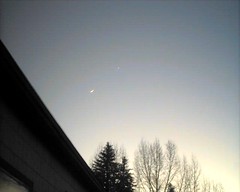| A meteor during the peak of the 2009 Leonid Meteor Shower. The photograph shows the meteor, afterglow, and wake as distinct components. (Photo credit: Wikipedia) |
I can’t believe I missed the meteor shower on Sunday morning, April 22, 2012.
In March, the Aspen night skies were on fire with astronomical wonders and so was I when it came to observing them – so what happened to April?
In April, the skies continued their spectacular Spring show, but I missed most of it. I didn’t make a point of viewing, or even planning to view, the night skies until near the very end of the month - Some Aspen Astronomer, huh!
Although throughout the month I occasionally thought about checking out the heavens, I disregarded these thoughts until April 24, 2012, when I was jolted by the sight of a sliver moon consorting with Venus in the western Aspen skies – what a spectacular sight! No wonder this phenomenon is often the source of UFO reports.
I hastily attempted to photograph this juxtaposition with an old SiPix 1.3 megapixel digital camera relic and ended up with only less-than-stellar (pun intended) photos of it, so I surfed around the internet for some higher quality images -- even mediocre would be better than mine.
Here are the results:
Bad photos (mine):
| Moon Near Venus Twilight 4/24/12 (Photo credit: richpalpine) |
| Moon Near Venus Nightime 4/24/12 (Photo credit: richpalpine) |
Better photos, and videos of the Moon and Venus, (not mine) may be found here:
Ok, so I did manage to log one astronomy event for April, but shortly after witnessing this fabulous Moon-Venus treat, I found out that I had missed one of the major annual springtime shows, the Lyrid meteor shower.
The Lyrids, which arrive each year around April 16, and continue until approximately April 26 , appear to radiate from the constellation, Lyra. They usually peak during the night of April 21/22, which fell this year on a Saturday/Sunday.
Now mind you, even though it was on a weekend, I probably wouldn’t have managed to drag myself out of bed at something like 3:00 AM to witness the peak of the Lyrid meteor shower early Sunday morning anyway; but if I’d been on top of it, I might have been able to see some activity Saturday night. Unfortunately, I was oblivious to the event until I received an email from a friend asking if I had seen it – sadly, I had to reply that I hadn’t.
I found out that although the Lyrids are considered a major annual meteor shower, they are not one of the most spectacular. This provided little consolation.
The next major annual meteor shower is the Eta Aquarid (ETA) which appears to radiate from the constellation Aquarius, and peaks on May 5/6th . This conveniently occurs, once again, on a weekend and I plan on attending.
Aquarius rises only a short time before morning twilight begins, but I will drag myself out of bed early Sunday morning to view this next meteor shower, binoculars and better camera in hand, and I will begin my quest to make May a more productive Aspen astronomy month than April was.




No comments:
Post a Comment